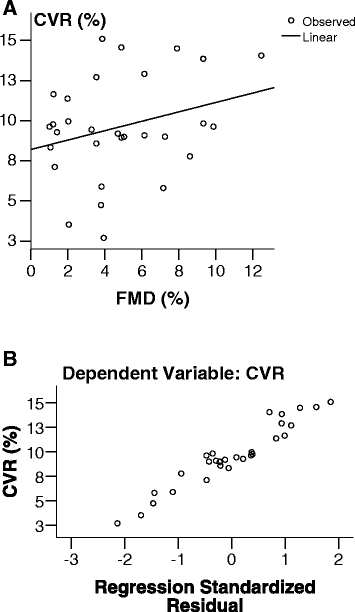The presence of cerebral and/or systemic endothelial dysfunction in patients with leukoaraiosis--a case control pilot study
- PMID: 26329797
- PMCID: PMC4557861
- DOI: 10.1186/s12883-015-0416-z
The presence of cerebral and/or systemic endothelial dysfunction in patients with leukoaraiosis--a case control pilot study
Abstract
Background: In spite of high prevalence and clinical relevance of leukoaraiosis (LA), its pathophysiology is still incompletely understood. Theories of ischaemic genesis and a leaky blood-brain barrier are contradictory yet could share a common denominator-endothelial dysfunction (cerebral, systemic or both), which has not been studied thoroughly in LA.
Methods: Thirty patients with LA (58 years (SD 7)) and 30 gender- and age-matched controls without LA (55 years (SD 6)) were recruited. The vascular risk factors (VRF) were identical in both groups. Cerebral endothelial function was determined by cerebrovascular reactivity to L-arginine (CVR). Systemic endothelial function was determined by flow-mediated dilatation (FMD) of the brachial artery after hyperaemia. All participants underwent a brain MRI to search for radiological signs of LA that was classified according to the Fazekas score. Linear regression was used to explore the correlation between CVR and FMD in patients with LA. A 95 % confidence interval was used. For any statistical test used in the study, p ≤ 0.050 was regarded as statistically significant.
Results: We found a marked and significant decrease in both CVR (9.6 % (SD 3.2) vs. 15.8 % (SD 6.1), p < 0.001) and FMD (4.8 % (SD 3.1) vs. 7.4 % (SD 3.8), p = 0.004) in LA patients compared to controls. Both CVR (7.4 % (SD 3.1) vs. 12.2 % (SD 2.6), p = 0.001) and FMD (3.0 % (SD 2.2) vs. 6.4 % (SD 3.1), p = 0.011) were significantly decreased in LA subgroup Fazekas 3 compared to subgroup Fazekas 1. CVR and FMD significantly positively correlated (b = 0.192, 95 % CI = 0.031-0.354, p = 0.02).
Conclusions: The results of our pilot study suggest that patients with LA have a significant impairment of both cerebral and systemic endothelial function that is larger than could be expected based on present VRF. Endothelial dysfunction increases in parallel with LA severity and correlates between cerebral and systemic arterial territory. Overall, our results suggest a so far unknown "intrinsic" generalised endothelial dysfunction in patients with LA that could be involved in LA pathophysiology. This interesting issue needs to be confirmed in larger samples since it could help better understand the mechanisms underlying LA.
Figures



Similar articles
-
Associations between cerebral and systemic endothelial function in migraine patients: a post-hoc study.BMC Neurol. 2011 Nov 15;11:146. doi: 10.1186/1471-2377-11-146. BMC Neurol. 2011. PMID: 22085841 Free PMC article.
-
Associations between systemic and cerebral endothelial impairment determined by cerebrovascular reactivity to L-arginine.Endothelium. 2007 Mar-Apr;14(2):73-80. doi: 10.1080/10623320701346692. Endothelium. 2007. PMID: 17497363 Clinical Trial.
-
Influence of atorvastatin treatment on L-arginine cerebrovascular reactivity and flow-mediated dilatation in patients with lacunar infarctions.Stroke. 2006 Oct;37(10):2540-5. doi: 10.1161/01.STR.0000239659.99112.fb. Epub 2006 Aug 24. Stroke. 2006. PMID: 16931784
-
Cerebral endothelial function determined by cerebrovascular reactivity to L-arginine.Biomed Res Int. 2014;2014:601515. doi: 10.1155/2014/601515. Epub 2014 Apr 17. Biomed Res Int. 2014. PMID: 24860826 Free PMC article. Review.
-
Chemical events behind leukoaraiosis: medicinal chemistry offers new insight into a specific microcirculation disturbance in the brain (a chemical approach to a frequent cerebral phenotype).Curr Med Chem. 2007;14(9):1027-36. doi: 10.2174/092986707780362907. Curr Med Chem. 2007. PMID: 17439400 Review.
Cited by
-
Impaired endothelial function may predict treatment response in restless legs syndrome.J Neural Transm (Vienna). 2019 Aug;126(8):1051-1059. doi: 10.1007/s00702-019-02031-x. Epub 2019 Jun 19. J Neural Transm (Vienna). 2019. PMID: 31218470
-
The Role of White Matter Damage in the Risk of Periprocedural Diffusion-Weighted Lesions after Carotid Artery Stenting.Cerebrovasc Dis Extra. 2017;7(1):1-8. doi: 10.1159/000452717. Epub 2017 Jan 27. Cerebrovasc Dis Extra. 2017. PMID: 28125807 Free PMC article.
-
Higher High-Mobility Group Box-1 Levels are Associated with White Matter Lesions in Ischemic Stroke Patients.J Inflamm Res. 2023 Oct 9;16:4441-4449. doi: 10.2147/JIR.S432109. eCollection 2023. J Inflamm Res. 2023. PMID: 37842188 Free PMC article.
-
Confining the Concept of Vascular Depression to Late-Onset Depression: A Meta-Analysis of MRI-Defined Hyperintensity Burden in Major Depressive Disorder and Bipolar Disorder.Front Psychol. 2019 May 31;10:1241. doi: 10.3389/fpsyg.2019.01241. eCollection 2019. Front Psychol. 2019. PMID: 31214072 Free PMC article.
-
Association between Leukoaraiosis and Poor Outcome is not due to Reperfusion Inefficiency after Intravenous Thrombolysis.Transl Stroke Res. 2016 Oct;7(5):439-45. doi: 10.1007/s12975-016-0473-7. Epub 2016 Jun 2. Transl Stroke Res. 2016. PMID: 27256491 Review.
References
Publication types
MeSH terms
Substances
LinkOut - more resources
Full Text Sources
Other Literature Sources

